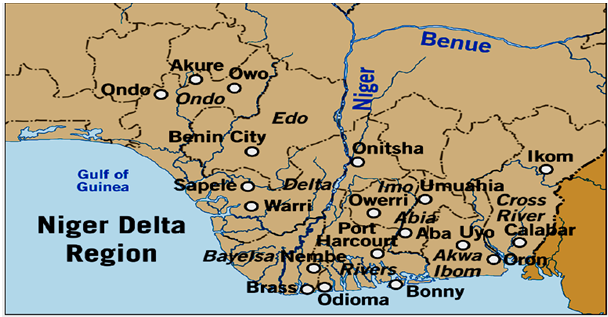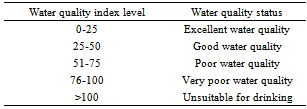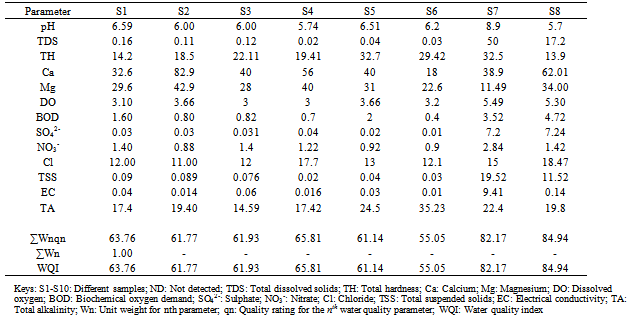-
Paper Information
- Next Paper
- Previous Paper
- Paper Submission
-
Journal Information
- About This Journal
- Editorial Board
- Current Issue
- Archive
- Author Guidelines
- Contact Us
Frontiers in Science
p-ISSN: 2166-6083 e-ISSN: 2166-6113
2013; 3(3): 89-95
doi:10.5923/j.fs.20130303.02
Water Quality Index for the Assessment of Water Quality from Different Sources in the Niger Delta Region of Nigeria
E. E. Etim1, R. Odoh1, A. U. Itodo1, S. D. Umoh2, U. Lawal1
1Department of Chemical Sciences, Federal University PMB, 1020, Wukari
2Department of Chemistry, University of Agriculture Makurdi
Correspondence to: E. E. Etim, Department of Chemical Sciences, Federal University PMB, 1020, Wukari.
| Email: |  |
Copyright © 2012 Scientific & Academic Publishing. All Rights Reserved.
Water quality of different sources of water (stream, borehole and pipe born water) in the Niger Delta region of Nigeria was evaluated by Water Quality Index (WQI) technique. The present investigations was carried out to compute the Water Quality Index (WQI) in order to assess the suitability of water from different sources collected from different areas in the Niger Delta region of Nigeria. In this study, WQI was determined on the basis of various physico-chemical parameters like pH, total alkalinity, chlorides, sulphate, nitrate, total hardness, calcium, magnesium, electrical conductivity, dissolved oxygen, biochemical oxygen demand, total dissolved solids and total suspended solids. The results obtained for the WQI from the different sampling stations were found to be varied from 34.80 to 36.26 for pipe borne water, 38.52 to 48.67 for borehole water and 55.05 to 84.94 for stream water. The results indicate that the different water samples analysed from pipe born and borehole water are safe for safe for human consumption and for other domestic purposes while the samples analysed from stream water are not safe for human consumption.
Keywords: Niger Delta, Physico-Chemical Parameters, Water, Water Quality Index
Cite this paper: E. E. Etim, R. Odoh, A. U. Itodo, S. D. Umoh, U. Lawal, Water Quality Index for the Assessment of Water Quality from Different Sources in the Niger Delta Region of Nigeria, Frontiers in Science, Vol. 3 No. 3, 2013, pp. 89-95. doi: 10.5923/j.fs.20130303.02.
Article Outline
1. Introduction
- Water of good drinking quality is of basic importance to human physiology and man’s continued existence depends very much on its availability. An average man (of 53 kg – 63 kg body weight), requires about 3 litres of water in liquid and food daily to keep healthy[1]. This fact apparently accounts for why water is regarded as one of the most indispensable substances in life and like air it is most abundant[2]. Increase in human population has exerted an enormous pressure on the provision of safe drinking water especially in developing countries[3]. Unsafe water is a global public health threat, placing persons at risk for a host of diarrheal and other diseases as well as chemical intoxication[4]. Most of the fresh water bodies all over the world are getting polluted, thus decreasing the portability of water[5]. The importance of water to man cannot be over emphasized. He can survive longer without food than without water. He requires it for his cooking, washing, sanitation, drinking and for growing his crops and running his factories. Therefore modern man like his primitive ancestors is heavily dependent on water for his sustenance. But because water is freely available through rainfall, until recently man has tended to take this resource for granted. Apart from its industrial use water is a necessary social amenity. The provision of good quality water can help in eradicating water-borne diseases and in improving the general sanitation of Nigeria's towns and villages[6].Water quality index (WQI) provides a single number that expresses the overall water quality at a certain location and time based on several water quality parameters. The objective of WQI is to turn complex water quality data into information that is understandable and usable by the public. A number of indices have been developed to summarize water quality data in an easily expressible and easily understood format. The WQI which was first developed by Horton in the early 1970s is basically a mathematical means of calculating a single value from multiple test results[7]. The index result represents the level of water quality in a given water basin, such as lake, river or stream. After Horton, a number of workers all over the world developed WQI based on rating of different water quality parameters[7]. Basically a WQI attempts to provide a mechanism for presenting a cumulatively derived, numerical expression defining a certain level of water quality[8]. The use of water quality index (WQI) simplifies the presentation of results of an investigation related to a water body as it summarises in one value or concept a series of parameters analysed. In this way, the indices are very useful to transmit information concerning water quality to the public in general, and give a good idea of the evolution tendency of water quality to evolve over a period of time. A single WQI value makes information more easily and rapidly understood than a long list of numerical values for a large variety of parameters. Additionally, WQI also facilitates comparison between different sampling sites and events[9]. Inadequate management of water resources as directly or indirectly resulted in the degradation of hydrological environment. Therefore, a continuous periodical monitoring of water quality is necessary so that appropriate steps may be taken for water resource management practices[10]. The present study is to serve as a baseline study since there is no literature regarding the water quality index in this region before now. The present investigations was carried out to compute the Water Quality Index (WQI) in order to assess the suitability of water from different sources collected from different areas in the Niger Delta region of Nigeria.The main objectives of the study are:• Collection of water samples from pipe borne water, bore hole water and stream water in the Niger Delta region of Nigeria.• Analysis of a few quality parameters viz., pH, total alkalinity, chlorides, sulphate, nitrate, total hardness, calcium, magnesium, electrical conductivity, dissolved oxygen, biochemical oxygen demand, total dissolved solids and total suspended solids as recommended by World Health Organization.• Assessment of the water quality using water quality index (WQI).
2. Materials and Methods
2.1. The Study Area
- The area of this study is the Niger Delta region of Nigeria. The Niger Delta covers an area of 70,000 Km2 of marshland, creeks, tributaries and lagoons that drain the Niger River into the Atlantic at the Bight of Biafra. About one-third of this area is fragile mangrove forest, the second largest mangrove forest in the world. The biodiversity of the Niger Delta is very high with the area containing diverse plant and animal species, including many endangered, exotic and endemic animals and plants[11]. The Niger Delta has an estimated population of over 30 million people[12], the bulk of which lives in rural fishing and farming communities .The region is also the headquarters of Nigeria’s oil and gas industry and currently the only oil and gas producing region in Nigeria[13]. Regrettably, activities of multinational oil companies have recently been linked to degradation of the natural environment, pollution and low agricultural productivity[14, 15] as well as insecurity of lives and property, hence, a reduction in quality of life expectations in Niger Delta communities[13]. The Niger Delta consists of the nine States of Abia, Akwa-Ibom, Bayelsa, Cross-River, Delta, Edo, Imo, Ondo and Rivers. Ethnically, the region consists of the Ijaw, Urhobo, Efik, Ibibio, Ogoni, Edo, Yoruba (mainly Itsekiri and Ilaje) and the Igbo[16]. The Niger Delta region is therefore of immense geopolitical, ecologic and economic importance. It is also an important agro-climatic region in Nigeria. Fig.1 shows the map of the Niger Delta region of Nigeria.
 | Figure 1. Map of the Niger Delta region of Nigeria |
2.2. Sample Collection
- Pipe borne water, borehole water and stream water samples from different states in the Niger Delta region of Nigeria were collected. All plastics and glasses utilized were pre-treated by washing with dilute HCl (0.05m) and later rinsed with distilled water. They were then air-dried in a dust free environment. At the collection point, containers were rinsed with relevant samples twice and filled with samples and then corked tightly.
2.3. Physico-Chemical Analysis
- The analysis of various physico-chemical parameters analyzed namely pH, total alkalinity, chlorides, sulphate, nitrate, total hardness, calcium, magnesium, electrical conductivity, dissolved oxygen, biochemical oxygen demand, total dissolved solids and total suspended solids were carried out as per methods described in[17,18].
2.4. Calculation of Water Quality Index
- In this study, for the calculation water quality index, thirteen important parameters were chosen. The WQI has been calculated by using standards of drinking water quality recommended by the World Health Organization (WHO) and Indian Council for Medical Research (ICMR). The weighted Arithmetic index method[19] has been used for the calculation of WQI in this study. Further, quality rating or sub index was calculated using the following expression.
 | (1) |
 | (2) |
 | (3) |
|
3. Results and Discussion
- The results of the physico-chemical parameters of the different samples of pipe borne water, bore hole water and stream water analysed are as shown in Tables 3, 4 and 5 respectively. From the results, it can be seen that the concentrations of the respective parameters are below the WHO/ICMR standards as shown in Table 2 except for some stream water samples. Water quality index indicates the quality of water in terms of index number which represents overall quality of water for any intended use[10]. In this study, the WQI is established from important physico-chemical parameters such as pH, total alkalinity, chlorides, sulphate, nitrate, total hardness, calcium, magnesium, electrical conductivity, dissolved oxygen, biochemical oxygen demand, total dissolved solids and total suspended solids.The results obtained for the WQI from the different sampling stations were found to be varied from 34.80 to 36.26 for pipe borne water, 38.52 to 48.67 for borehole water and 55.05 to 84.94 for stream water. The results indicate that the different water samples analysed from pipe born and borehole water are safe for safe for human consumption and for other domestic purposes while the samples analysed from stream water are not safe for human consumption[8]. The above water quality index is supported by the following physico-chemical parameters, namely pH, total alkalinity, chlorides, sulphate, nitrate, total hardness, calcium, magnesium, electrical conductivity, dissolved oxygen, biochemical oxygen demand, total dissolved solids and total suspended solids. The variations of the above physico-chemical parameters observed among the different water samples were all within the recommended standards. Among all the physico-chemical parameters selected for the WQI calculations, pH is an important parameter which determines the suitability of water for various purposes [20]. In the present study, pH ranges from 6.87 to 7.05, 6.53 to 7.20 and 5.74 to 8.9 for the entire pipe borne water, borehole water and stream water samples analyzed respectively. This shows that the pH rabge obtained for the stream waqter samples (5.74 to 8.90) was outside the recommended range of 6.50 to 8.50[21, 22]. High pH levels are undesirable since they may impart a bitter taste to the water. Furthermore, the high degree of mineralization associated with alkaline water will result in the encrustation of water pipes and water-using appliances. The combination of high alkalinity and calcium with low pH levels may be less corrosive than water with a combination of high pH, low alkalinity and calcium content. High pH levels also depress the effectiveness of disinfection by chlorination, thereby requiring the use of additional chlorine or longer contact times[5]. The pH of most natural water bodies range from 6.5 to 8.5 while the deviation from neutral pH is as a result of free carbon dioxide or bicarbonate in the water body[23].In natural water, dissolved solids are composed mainly of carbonates, bicarbonates, chlorides, sulphates, phosphates, nitrates, calcium, magnesium, sodium, potassium, iron and manganese[5]. They originate from dissolution or weathering of the rocks and soil, including dissolution of lime, gypsum and other slowly dissolved soil minerals. Total dissolved solids (TDS) in all the water samples analysed were within the recommended standards for drinking water. TDS in drinking water has also been associated with natural source, sewage, industrial wastewater, urban run-off and chemical used in water treatment process[24]. Hardness is a measure of the ability of water to cause precipitation of insoluble calcium and magnesium salts of higher fatty acids from soap solutions. The principal hardness causing ions are Calcium, Magnesium Bicarbonate, Carbonate, Chloride and Sulphate[8]. The total hardness values of the present study were found to range between 10.92 to 16.07, 27.50 to 60.31 and 14.20 to 32.70 mg/l for the entire pipe borne water, bore hole water and stream water samples analysed respectively.
|
|
|
|
4. Conclusions
- Assembling different parameters into one single number leads an easy interpretation of index, thus providing an important tool for management purposes. An index is a useful tool for "communicating water quality information to the public and to legislative decision makers;" it is not "a complex predictive model for technical and scientific application". From the application of water quality index for the determination of the quality of water from different sources in the Niger Delta region of Nigeria, it is concluded that all the pipe borne water and bore hole water samples analysed in this study are fit and suitable for drinking and for other domestic applications while the stream water samples are found unfit and unsuitable for human consumption based on the water quality index standard applied in this study. The source of pollution of these streams as observed at the site includes human activities as defecation and dumping of untreated waste. The streams could be free or level of pollution reduced if proper measures are put in place to discourage the users from polluting the water in order to bring about improved health.
 Abstract
Abstract Reference
Reference Full-Text PDF
Full-Text PDF Full-text HTML
Full-text HTML



